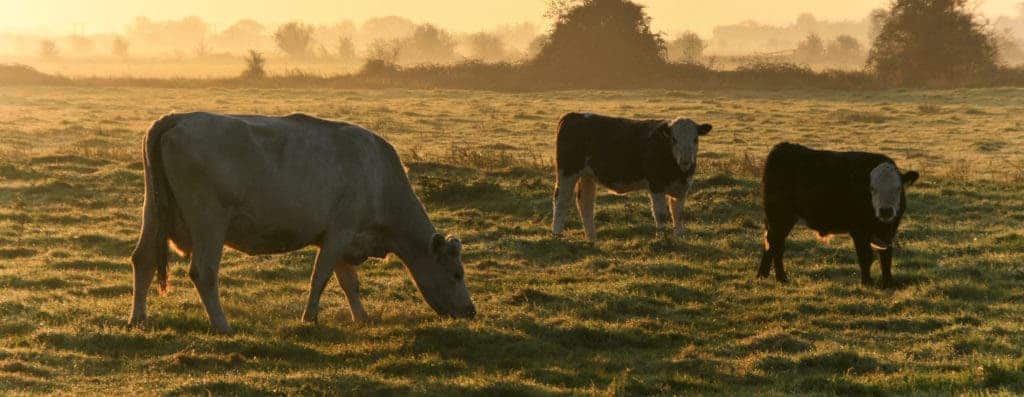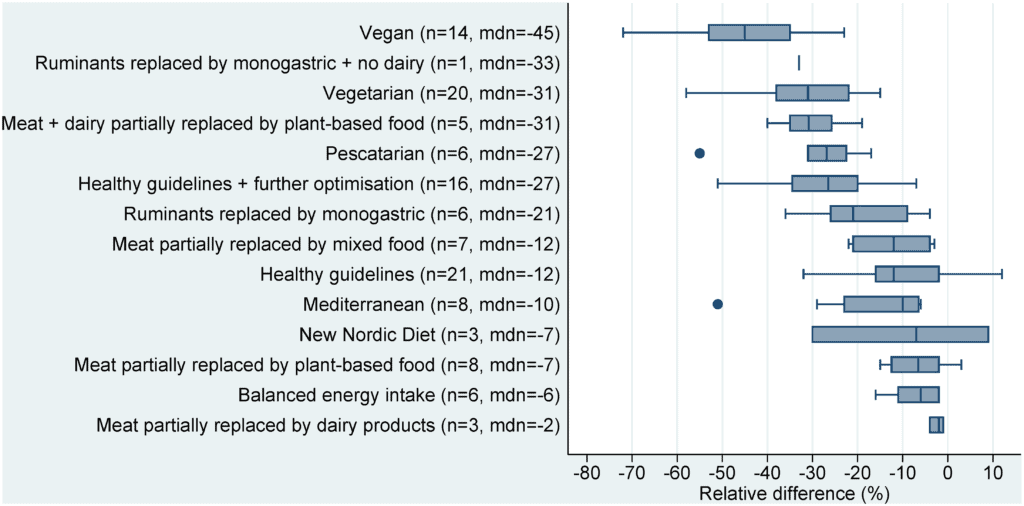Want to know the easiest way to both reduce greenhouse gas emissions and dramatically improve your overall health? Eat less meat.
The unseen cost of meat

Lukasz Aleksandrowicz, a researcher from the London School of Hygiene and Tropical Medicine reviewed 63 studies quantifying the effect of switching from a traditional Western diet to one that’s less meat-intensive. He found that you can reduce your personal emissions and land use footprint by 70–80% and your embedded water consumption by 50% just by adopting sustainable dietary patterns.
“Food production is a major driver of greenhouse gas (GHG) emissions, water and land use, and dietary risk factors are contributors to non-communicable diseases,” the study reads. “Shifts in dietary patterns can therefore potentially provide benefits for both the environment and health. “
The main culprit was, by far, meat.
For most people, the environmental cost of meat comes as a surprise. At a global scale, livestock (including poultry) accounts for about 14.5 percent of anthropogenic greenhouse gas emissions. Other estimates put that figure closer to 18 percent – and that’s just the tip of the iceberg. In general, meat consumes an enormous amount of resources, relative to other types of food. The 2006 report Livestock’s Long Shadow, released by the Food and Agriculture Organization (FAO) of the United Nations, states that:
“The livestock sector is a major stressor on many ecosystems and on the planet as a whole. Globally it is one of the largest sources of greenhouse gases and one of the leading causal factors in the loss of biodiversity, while in developed and emerging countries it is perhaps the leading source of water pollution.”
“Ranching-induced deforestation is one of the main causes of loss of some unique plant and animal species in the tropical rainforests of Central and South America as well as carbon release in the atmosphere.” This has implications for—among other things—meat consumption in Europe, which imports significant amounts of feed from Brazil.”
In comparison with grazing, intensive livestock production requires large quantities of harvested feed. It famously takes seven pounds of feed to produce a pound of beef (live weight), compared to more than three pounds for a pound of pork and less than two pounds for a pound of chicken. Furthermore, the concept of embedded (or virtual) water should also be considered. Basically, it takes a lot of water to produce meat: some 4,000 liters of water per kilogram of chicken (500 gallons / pound), and 4 times more for beef!
When you consider that 30-50% of global food is thrown away without being touched by a human, those figures become even more worrying. The solution, or at least one of the solutions, is adopting a better diet.
A diet for the future of the planet
So not only does reducing meat (especially red meat) help your health, but it does wonders for the planet as well – in many cases, more than walking to work instead of driving. But Aleksandrowicz wanted to see just how much of a difference it could make. Of course, dietary patterns are extremely varied and complex so he looked at numerous scenarios.
“Fourteen sustainable dietary patterns were proposed: vegetarian, vegan, pescatarian, replacing ruminant with monogastric meat [ie replacing beef with chicken], balanced energy intake, following healthy guidelines, Mediterranean diet, New Nordic diet, and meat reduction, with other sub-scenarios such as type of food supplemented by meat reduction, and healthy guidelines with further optimisation.”
Within these 14 patterns, 210 scenarios were analyzed and 197 showed a reduction in environmental impacts when switching from baseline to alternative dietary patterns. The rest 13 showed either no change or a negative one, and most these scenarios featured some implementation of the New Nordic diet – everything else was generally better. The changes were significant.
“The median changes in GHG emissions, land use, and water use, across all sustainable diet types, were -22%, -28%, and -18%, respectively. The largest environmental benefits across indicators were seen in those diets which most reduced the amount of animal-based foods, such as vegan (first place in terms of benefits for two environmental indicators), vegetarian (first place for one indicator), and pescatarian (second and third place for two indicators).”
Basically, if you reduce animal products you have the best results – if you simply replace meat for dairy products, the positive effect is diminished significantly. But even more excitingly, these are the median results – in some scenarios, the results are much better, especially in Western countries.
“Our review showed that reductions above 70% of GHG emissions and land use, and 50% of water use, could be achieved by shifting typical Western diets to more environmentally sustainable dietary patterns.”
Of course, completely eliminating meat is unrealistic in most places of the world and for most people, but even reducing it can make a big difference. In order for this to happen, an active effort has to be made – and the price has to also come down a bit for healthy foods.
“Studies have shown that large reductions in GHG emissions are possible without complete exclusion of animal products, and studies using self-selected sustainable diets imply these could be culturally appropriate for at least some individuals. However, extending these patterns to the majority of the population will require large efforts. In HICs, healthy foods are often more expensive than unhealthy ones, and rebalancing these relative prices will be critical to help steer consumers towards more sustainable choices.”
All in all, the implications are clear: the environmental cost of meat is huge. Even by just meat consumption, we can all make a big difference in terms of greenhouse gas emissions, water consumption and land use.
Journal Reference: The Impacts of Dietary Change on Greenhouse Gas Emissions, Land Use, Water Use, and Health: A Systematic Review



